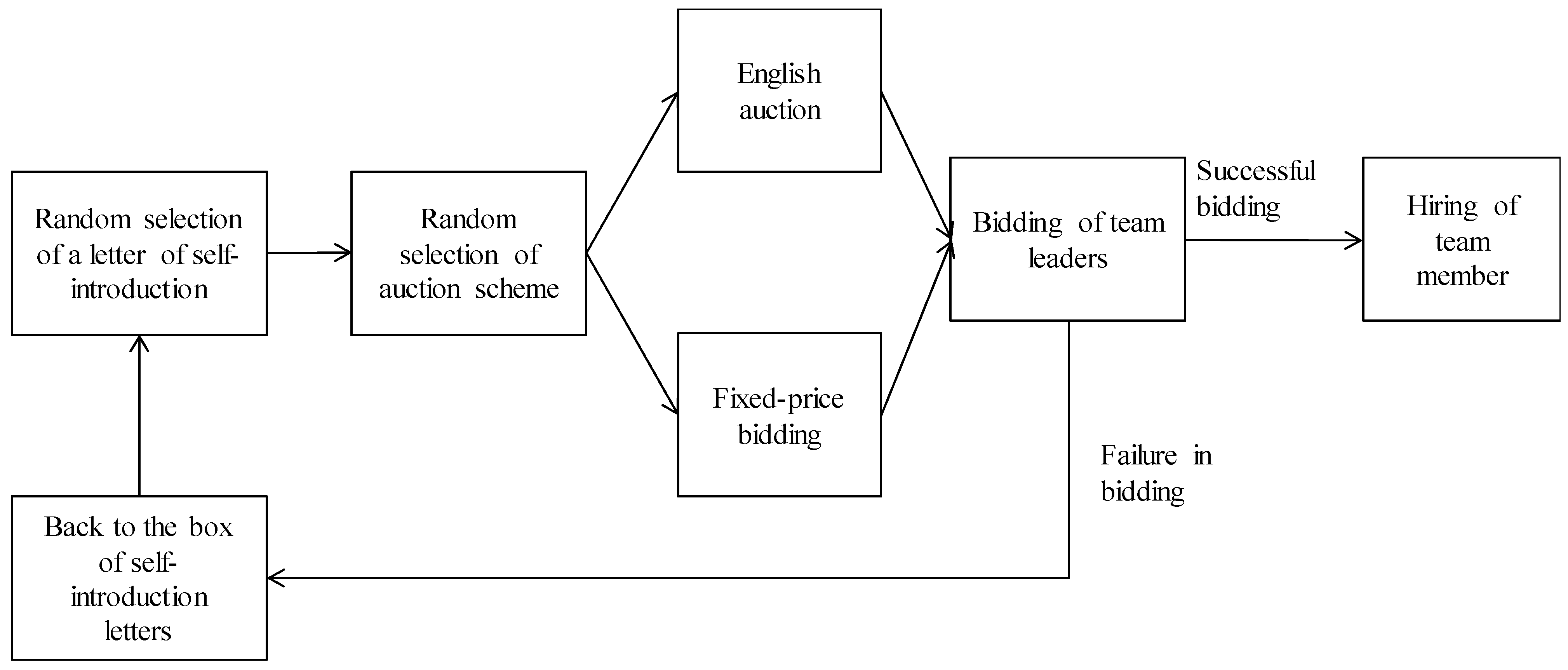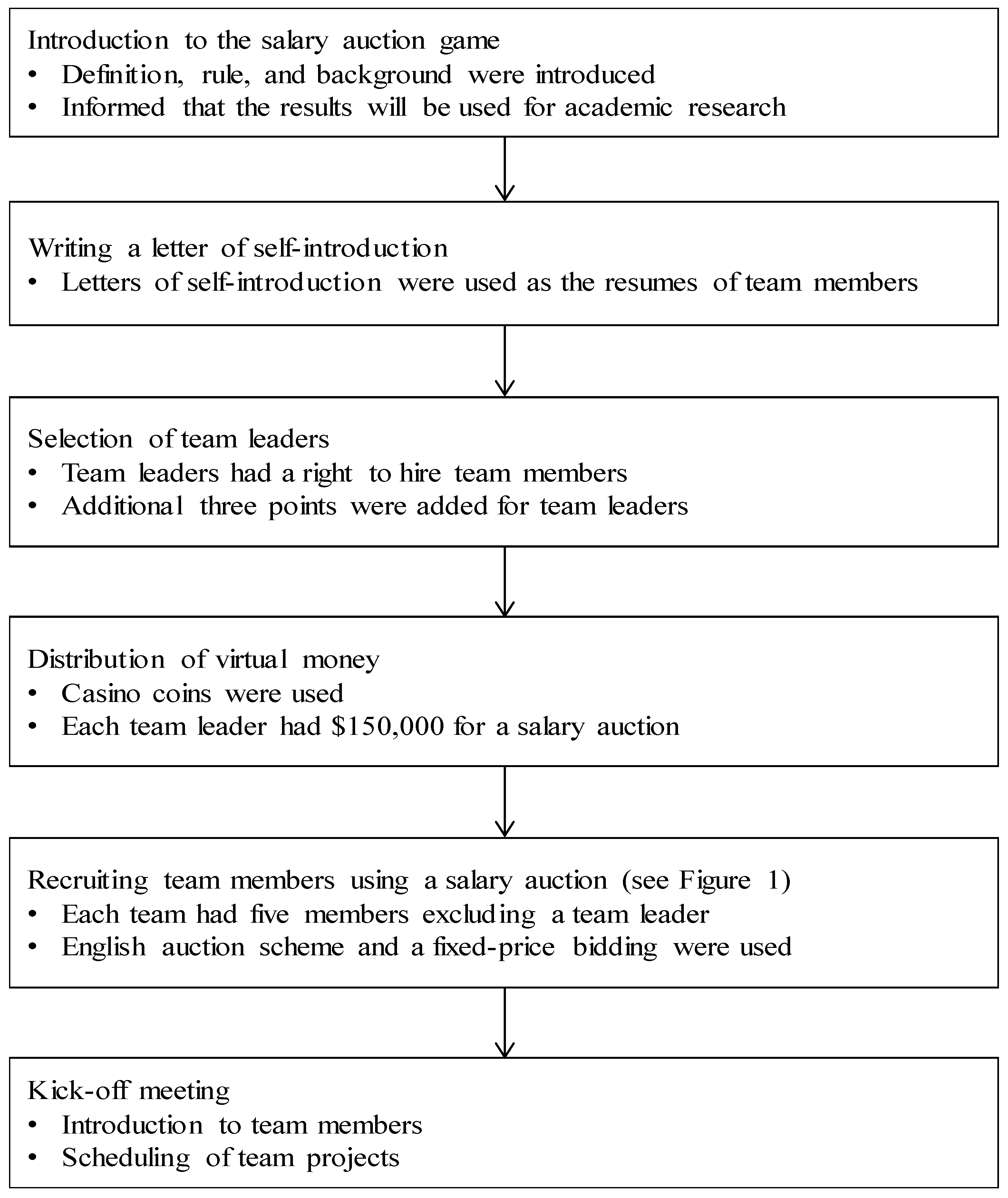Team Organization Method Using Salary Auction Game for Sustainable Motivation
Abstract
:1. Introduction
2. Literature Review
2.1. Motivation Theory
2.2. Gamification
| Categories | Elements |
|---|---|
| Rewards | Points, Levels, Progression, Badge, Authority, Virtual Items, Physical Goods, Severance, Gifting, Free Items, Virtual Money |
| Reward Schedules | Fixed Interval Reward Schedules, Fixed Ratio Reward Schedules, Variable Interval Reward Schedules, Variable Ratio Reward Schedules |
| Avoidance | Disincentives, Leaky Bucket |
| Leader Board | Macro Leader Board, Micro Leader Board, Indirect competition, Direct Competition |
| Status | Avatar, Social Graph |
| Quests | Content Unlocking, Countdown, Lottery, Communal Discovery, Scaffolding |
2.3. Types of Gamers
| Game Player Type | Key Characteristics |
|---|---|
| Opportunists | They are implicit achievers. |
| They do not miss a chance. | |
| They look around to find something to do without knowing what it is until they find it. | |
| If they encounter an obstacle, they do something else instead. | |
| Planners | They are explicit achievers. |
| They like setting a goal and achieving it. | |
| They design a large plan and perform actions for that plan. | |
| If they encounter an obstacle, they avoid it. | |
| They persistently pursue their idea. | |
| Scientists | They are explicit explorers. |
| They make theories using experiments. | |
| They acquire knowledge methodically. | |
| They explain phenomena. | |
| Hackers | They are implicit explorers. |
| They want to reveal meaning by experiment. | |
| They try to discover new phenomena faster than others. | |
| They have a strong intuitive understanding of the virtual world. | |
| Networkers | They are explicit socializers. |
| They try to find people to interact with. | |
| They think of other players as fellows and want to know their fellow players. | |
| They learn who and what their fellow players know. | |
| Friends | They are implicit socializers. |
| They want to interact with players they already know. | |
| They have a deep understanding of their fellow players. | |
| They never mind the human weakness of fellow players. | |
| Griefers | They are implicit killers. |
| They always like attacking others. | |
| They are daring and brave. | |
| They hope to get a big and notorious reputation from other players. | |
| It is very difficult to explain why they act as griefers. | |
| Politicians | They are explicit killers. |
| They always act with forethought and foresight. | |
| They foxily manipulate people. | |
| They try to justify their decisions and actions in terms of their contribution and sacrifice for the virtual world. | |
| They aim to get a good reputation and raise awareness. |
3. Salary Auction Game

4. A Case Study

4.1. Evaluation Using Self-Assessment
- Q4: Does the salary auction game increase your concern for team members?
- Q5: Does the salary auction game increase the initiative of the student in the team-building process?
- Q6: Does the salary auction game let you have fun while learning?
- Q7: Does the salary auction game improve the sense of responsibility of team members?
- Q8: Does the salary auction game make you feel you are having fun in performing team projects?
- Q9: Does the salary auction game improve the quality of team projects’ outcomes?
- Q10: Would you like to recommend the salary auction scheme to other classes?
| N | Mean | Std. Deviation | Std. Error Mean | |
|---|---|---|---|---|
| Q4 | 33 | 3.4848 | 0.71244 | 0.12402 |
| Q5 | 33 | 3.5455 | 0.75378 | 0.13122 |
| Q6 | 33 | 3.8485 | 0.83371 | 0.14513 |
| Q7 | 33 | 3.0909 | 0.94748 | 0.16494 |
| Q8 | 33 | 3.4848 | 0.93946 | 0.16354 |
| Q9 | 33 | 3.3636 | 0.65279 | 0.11364 |
| Q10 | 33 | 3.4545 | 0.93845 | 0.16336 |
| Test Value = 3 | ||||||
|---|---|---|---|---|---|---|
| t-Value | Degree of Freedom | Significance Probability (two-tailed) | Mean Difference | 95% Confidence Interval of the Difference | ||
| Lower | Upper | |||||
| Q4 | 3.909 | 32 | 0.000 | 0.48485 | 0.2322 | 0.7375 |
| Q5 | 4.157 | 32 | 0.000 | 0.54545 | 0.2782 | 0.8127 |
| Q6 | 5.846 | 32 | 0.000 | 0.84848 | 0.5529 | 1.1441 |
| Q7 | 0.551 | 32 | 0.585 | 0.09091 | −0.2451 | 0.4269 |
| Q8 | 2.965 | 32 | 0.006 | 0.48485 | 0.1517 | 0.8180 |
| Q9 | 3.200 | 32 | 0.003 | 0.36364 | 0.1322 | 0.5951 |
| Q10 | 2.782 | 32 | 0.009 | 0.45455 | 0.1218 | 0.7873 |
4.1.1. Does the Salary Auction Game Increase Your Concern for Team Members?
4.1.2. Does the Salary Auction Game Increase the Initiative of the Student in the Team-Building Process?
4.1.3. Does the Salary Auction Game Let You Have Fun While Learning?
4.1.4. Does the Salary Auction Game Improve the Sense of Responsibility of Team Members?
4.1.5. Does the Salary Auction Game Make You Feel You Are Having Fun in Performing Team Projects?
4.1.6. Does the Salary Auction Game Improve the Quality of Team Projects’ Outcomes?
4.1.7. Would You Like to Recommend the Salary Auction Scheme to Other Classes?
4.2. Evaluation by the Third Party
| Assessor | A | B | C | |
|---|---|---|---|---|
| Subject | ||||
| 2013 | Responsibility | 5.3 | 5.3 | 5.5 |
| Quality | 5.7 | 6.2 | 6.2 | |
| 2014 | Responsibility | 6.3 | 6.7 | 7.2 |
| Quality | 6.5 | 7.2 | 6.7 |
5. Conclusions
- It is the first gamification case that applies an auction game theory to the team-building process;
- Considering the rapidly increasing interest in the gamification of learning and education, the proposed team organization method using the salary auction game could receive great attention from school teachers, educationalists, and gamification researchers;
- The proposed salary auction game proved to be an effective tool which motivates students and makes them have fun and could be applied to the higher educational field.
- This study blended different fields of motivation theory and game mechanism to suggest an innovative method for team organization in engineering class;
- The proposed salary auction game enhances the intrinsic responsibility of the students, which creates sustainable motivation;
- A team organization method using the salary auction game is helpful to improve the quality of team-based projects from the point of view of the students.
- The reason(s) why a team organization method using the salary auction game is not helpful in enhancing the responsibility of team members should be further investigated;
- The positive value and side effects of each game mechanism in the salary auction game should be studied item by item;
- The difference of learning effects or motivation regarding Bartle’s player types of planner, networker, and friend should be analyzed.
Acknowledgments
Conflicts of Interest
References
- Jarvenpaa, S.L.; Leidner, D.E. Communication and trust in global virtual teams. J. Comput. Mediat. Commun. 1998, 3, 1–36. [Google Scholar] [CrossRef]
- Kim, S. Teaching method using job assignment as a solution on the adverse effects of peer evaluation in team-based learning. J. Korea Acad. Ind. Coop. Soc. 2011, 12, 2543–2547. [Google Scholar] [CrossRef]
- Felder, R.M.; Felder, G.N.; Dietz, E.J. A longitudinal study of engineering student performance and retention. J. Eng. Educ. 1998, 87, 469–480. [Google Scholar] [CrossRef]
- Kim, C.J. Introduction to Education Psychology; Dongmoonsa: Seoul, Korea, 2012. [Google Scholar]
- Lussier, R.N.; Achua, C.F. Leadership, Theory, Application, & Skill Development; South-Western College Publishing: Mason, OH, USA, 2012. [Google Scholar]
- Meer, H. Intrinsic Motivation and Extrinsic Motivation. Available online: http://studyob.com/intrinsic-motivation-extrinsic-motivation/ (accessed on 15 October 2015).
- Kim, S. Enjoy Your Education Like a Gaming; Hongreung: Seoul, Korea, 2014. [Google Scholar]
- Kim, S. College Student Manual for Immature Adults; Doonam: Seoul, Korea, 2014. [Google Scholar]
- Csikszentmihalyi, M. Good Business, Leadership: Flow, and the Making of Meaning; Penguin Books: London, UK, 2004. [Google Scholar]
- Papastergiou, M. Digital game-based learning in high school computer science education: Impact on educational effectiveness and student motivation. Comput. Educ. 2009, 52, 1–12. [Google Scholar] [CrossRef]
- Kim, S.; Ko, I.S. Toward gamified classroom: Classification of engineering students based on the Bartle’s player types model. Int. J. Digit. Content Technol. Appl. 2013, 7, 25–31. [Google Scholar]
- Kim, S. Analysis of engineering students’ needs for gamification based on PLEX model. J. Knowl. Data Eng. 2013, 1, 1–7. [Google Scholar]
- Kim, S. Effects of the gamified class in engineering education environments. J. Converg. Inf. Technol. 2013, 8, 253–260. [Google Scholar]
- McGregor, D. The Human Side of Enterprise; McGrawHill: New York, NY, USA, 1960. [Google Scholar]
- Maslow, A.H. A theory of human motivation. Psychol. Rev. 1943, 50, 370–396. [Google Scholar] [CrossRef]
- Alderfer, C.P. An empirical test of a new theory of human needs. Organ. Behav. Hum. Perform. 1969, 4, 142–175. [Google Scholar] [CrossRef]
- Schonfeld, E. SCVNGR’s Secret Game Mechanics Playdeck; TechCrunch: Bay Area, CA, USA, 2010. [Google Scholar]
- Nielson, B. Gamification Mechanics vs. Gamification Dynamics. Available online: http://www.yourtrainingedge.com/gamification-mechanics-vs-gamification-dynamics/ (accessed on 15 October 2015).
- Duggan, K.; Shoup, K. Business Gamification for Dummies; John Wiley & Sons: Hoboken, NJ, USA, 2013. [Google Scholar]
- Werbach, K.; Hunter, D. For the Win: How Game Thinking Can Revolutionize Your Business; Wharton Digital Press: Philadelphia, PA, USA, 2012. [Google Scholar]
- Zichermann, G.; Linder, J. The Gamification Revolution: How Leaders Leverage Game Mechanics to Crush the Competition; McGraw-Hill: Rockefeller, NY, USA, 2013. [Google Scholar]
- Reeves, B.; Cumming, J.J.; Anderson, D. Leveraging the Engagement of Games to Change Energy Behavior. In Proceeding of Conference on Human Factors in Computing Systems, Vancouver, BC, Canada, 7–12 May 2011.
- Herger, M. Roadwarrior: How SAP Trains Its Sales People on Mobility; Enterprise-Gamification: Los Altos, CA, USA, 2012. [Google Scholar]
- Siemens Taps into Zynga’s Popularity, Launches PlantVille. Available online: http://www.fastcompany.com/1742355/siemens-taps-zyngas-popularity-launches-plantville (accessed on 30 November 2014).
- Ribbon Hero—User Assistance Masquerading as a Game. Available online: http://www.writersua.com/articles/ribbon_hero (accessed on 30 November 2014).
- Thiagarajan, S. Thiagi’s 100 Favorite Games; Pfeiffer: San Francisco, CA, USA, 2006. [Google Scholar]
- Kim, S. The educatees’ perception change of learning motivation and fairness on feedback using app. J. Korea Game Soc. 2015, 15, 79–86. [Google Scholar] [CrossRef]
- Hearts, Clubs, Diamonds, Spades: Players Who Suit MUDs. Available online: http://mud.co.uk/richard/hcds.htm (accessed on 23 January 2015).
- Bartle, R. Virtual worlds: Why people play. Massively Mult. Game Dev. 2015, 2, 3–18. [Google Scholar]
- Bunchball. An Introduction to the Use of Game Dynamics to Influence Behavior; Bunchball: San Mateo, CA, USA, 2010. [Google Scholar]
© 2015 by the authors; licensee MDPI, Basel, Switzerland. This article is an open access article distributed under the terms and conditions of the Creative Commons Attribution license (http://creativecommons.org/licenses/by/4.0/).
Share and Cite
Kim, S. Team Organization Method Using Salary Auction Game for Sustainable Motivation. Sustainability 2015, 7, 14358-14370. https://doi.org/10.3390/su71014358
Kim S. Team Organization Method Using Salary Auction Game for Sustainable Motivation. Sustainability. 2015; 7(10):14358-14370. https://doi.org/10.3390/su71014358
Chicago/Turabian StyleKim, Sangkyun. 2015. "Team Organization Method Using Salary Auction Game for Sustainable Motivation" Sustainability 7, no. 10: 14358-14370. https://doi.org/10.3390/su71014358





